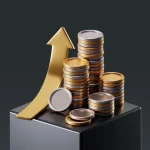Economists keep saying the U.S. economy is okay. Retail sales are steady, the job market is still good, and Wall Street thinks we can avoid a big crash. The numbers look good, but if you talk to regular people, they’ll tell you a different story. People feel like they’re struggling.
Prices aren’t rising as fast as last year, but they’re still high. Food costs a lot. Rent keeps increasing. Gas prices jump around and never stay the same. Add that to interest rates, the highest they’ve been in over 20 years, and you can see why so many people are having a hard time. A new report puts it simply. Credit card debt is at a record high. People are missing payments. Young people have student loans and are also struggling. Even credit scores are dropping, which means people are using all the money they have.

For many families, the numbers just don’t work anymore. A paycheck that used to pay for everything barely lasts the whole month. Buying a house seems impossible. Car loans? Forget it. Even middle-class families with good jobs are cutting back, skipping vacations, using their savings, or not buying things they used to buy. It’s not just about numbers. It’s about daily life. Parents are buying cheaper brands. College grads are moving back home because rent is too high. Retirees thought they could relax, but now have to work part-time. Inflation and high interest rates are making people spend all their money, change their lives, put off their dreams, and change their plans.
The Federal Reserve is causing this. Over the last couple of years, the Fed has increased interest rates to slow down inflation. It kind of worked. Inflation slowed down, and the markets got better. But there’s a cost. Every time the rate went up, mortgages, credit card debt, and car loans became more expensive. For families who were already struggling, what the Fed did is making things worse. Inflation isn’t as bad, but borrowing money is costing too much. People are stuck, prices are still high, and interest rates are really high.
People think the Fed might lower rates soon, maybe even this week. Traders are happy, and stocks are going up. But for families who have been struggling to pay bills and getting into debt, it might be too late. Lowering rates now won’t fix the stress of the last year.
Companies see it too. Companies like Walmart and Ford say consumers are changing what they buy. People are buying less, focusing on needs instead of wants. Also, families are keeping their cars for longer. Even cheap stores say people are having a hard time. It’s a cycle. Prices increase, interest payments increase, and consumers buy less. This hurts the economy and slows down growth for everyone.
Still, Americans can handle a lot. They make it work, juggle things, and save money in ways that seem impossible. That’s why the economy hasn’t crashed, even though people are frustrated. People keep things going, but it’s costing them less savings, more debt, and more stress. Things are getting bad. More people are missing credit card payments. Savings rates are going down, and consumer confidence has fallen. Economists say these are signs that financial pressure could slow growth, hurt the job market, and maybe even cause a recession if things continue. The question is, how much longer can people deal with this? Trump’s trade taxes are making things worse. Higher import prices on things like shoes and appliances are being passed on to shoppers, and people have less money.
So, where are we? Somewhere in the middle. The economy isn’t falling apart, but people are hurting. Inflation has cooled, but not enough to help. Interest rates might decrease soon, but the debt won’t go away. The real story isn’t about GDP reports. It’s about the mom working extra to pay rent, the grad dealing with student loans, and the retiree skipping travel plans because food and gas cost too much.
The numbers say one thing, but people say another. And right now, that human story is hard to ignore.











